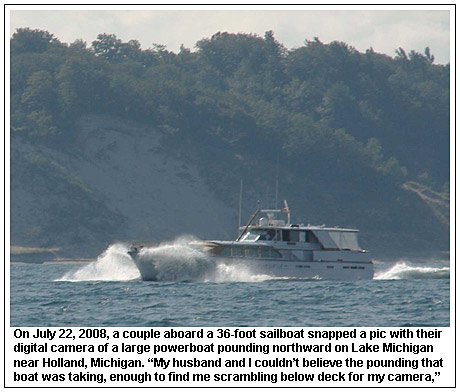|
Distress signals may not always attract attention
by Tom Rau
In
most cases, visual distress signals will attract
attention to a boater in need, but not always.
In those rare cases where they fail to catch the
eye, it may have little to do with the eye but
rather much to do with the type of distress
signal device the eye can detect. Types can be
as different as night and day—literally.
And so it was literally the case regarding a
recent lifesaving rescue. On July 22, 2008, a
22-foot powerboat rolled over, leaving five
fishermen clinging to the hull. The capsizing
happened around 10 a.m. on Lake Michigan about
three miles off Holland, Michigan.
 In an urgent effort to draw attention, the
stranded boaters set off several flares they
managed to extract from the overturned boat. The
hand-held red flares went unnoticed. Determined
to attract attention, they attached a distress
flag to a fishing pole and waved it overhead.
Nearly two hours after the capsizing the orange
3ft x 3ft flag displaying a black square and
ball symbol caught the eye of a couple onboard a
nearby sailboat. In an urgent effort to draw attention, the
stranded boaters set off several flares they
managed to extract from the overturned boat. The
hand-held red flares went unnoticed. Determined
to attract attention, they attached a distress
flag to a fishing pole and waved it overhead.
Nearly two hours after the capsizing the orange
3ft x 3ft flag displaying a black square and
ball symbol caught the eye of a couple onboard a
nearby sailboat.
“When my husband and I first spotted the flag,
we
first thought it might be a flag used to mark
fishing nets,”
said Tina Kelsey. “But then my
husband, Bill, noticed the flag moved out of
sync with the wave motion.”
Tina aimed in on the flag with binoculars and
recognized the orange flag with a black square
and ball as a day-time international distress
signal, knowledge she had acquired in a United
States Power Squadron boating safety course. She
immediately called the Coast Guard on VHF-FM
Channel 16, the International Distress
Frequency.
Coast Guardsman, Andrew Duhaime, Station
Holland, picked up the call. “The caller right
off provided a position and that she had two
people in sight in the water. By the time she
made a second call, we were on the rescue boat
racing towards the latitude and longitude
position she provided,” said Duhaime.
“I
can’t believe how quickly they got to us,” said
Tina Kelsey. When the Holland Coast Guard rescue
boat arrived, all five of the survivors were
aboard the sailboat. They were transferred to
the Coast Guard rescue boat and returned to
shore.
A combination of a visual distress signal and
VHF-FM marine radio drew the eye and ear that
led to a successful rescue.
Ironically, Tina Kelsey had a half hour earlier
snapped a pic on her digital camera of a 65-foot
powerboat pounding northward into head seas. “My
husband and I couldn’t believe the pounding that
boat was taking, enough to find me scrambling
below deck for my camera,” said Tina. Several
hours later the large boat would break up off
Little Point Sable.
The captain of the doomed craft fired off an
urgent Mayday over VHF-FM Channel 16. A nearby
boater heard the Mayday and raced to the rescue.
The boat sank in moments, leaving a father and
his teenage son in desperate straits. Yet, with
a heap of hope: both were wearing life jackets.
Hopefully their life jackets carried distress
signals: in particular, a day-time orange smoke
signal in the event the radio distress call went
unheard. As it turned out, both were rescued by
a “Good Sam” who picked up the distress call
along with the Coast Guard.
A lady on shore captured this dramatic boat
break-up on a camcorder that caught one of the
crewman leaping off the stern.
Whether it be flares, distress flags, or the
marine radio, one or all promise to save your
life in an emergency. Boat Smart—carry them all.
Tom
Rau is a long-time Coast Guard rescue responder
and syndicated boating safety columnist.
Look for his book, Boat Smart Chronicles, a
shocking expose on recreational boating — reads
like a great ship’s log spanning over two
decades. It’s available to order at:
www.boatsmart.net, www.seaworthy.com,
www.amazon.com,
or through local bookstores.
TOP
|